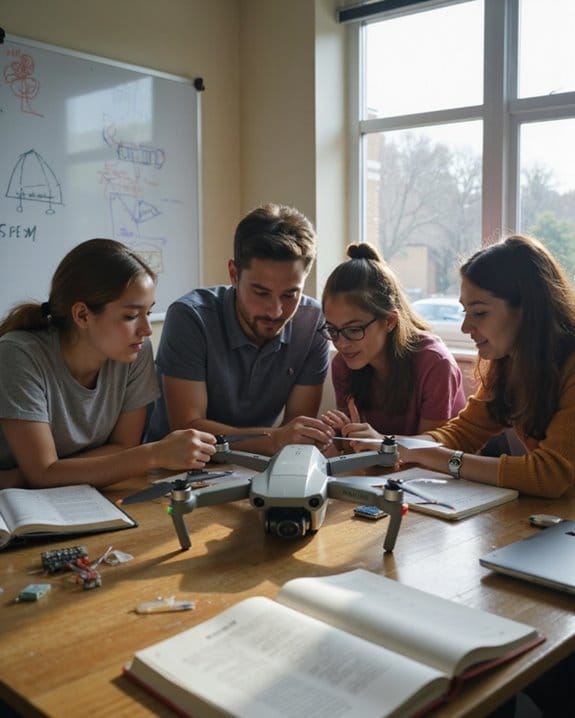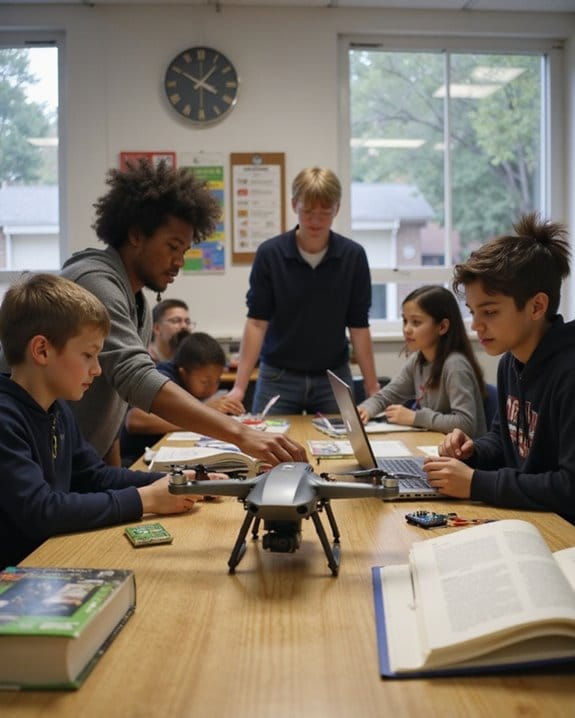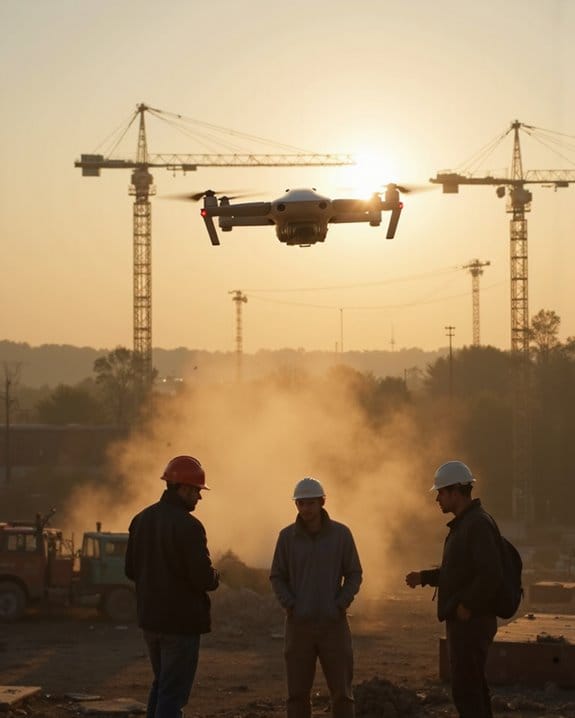Drones are transforming education because you’re no longer stuck just learning theories—you get to fly, code, and collect real-world data right in class. Students as young as kindergarten can explore flight basics, while high schoolers tackle advanced programming and prep for industry certifications. You’ll see drones boost STEM skills, improve teamwork, and reflect real career needs, especially with the tech sector expecting over 100,000 new jobs soon. Interested in how drones fit different ages and learning goals? Keep going.
Key Takeaways
- Drones provide hands-on STEM learning, connecting classroom concepts to real-world applications in fields like engineering, coding, and environmental science.
- Students develop future-ready skills, including programming, data analysis, and sensor technology, preparing them for high-tech careers.
- Layered drone curricula support all ages, from simple piloting in kindergarten to advanced programming and certification in high school.
- Drone programs foster inclusivity by engaging underrepresented groups, helping close gender and diversity gaps in technology fields.
- The growing drone sector creates new job opportunities, with education programs aligning student skills to workforce demands and industry certifications.
The Rise of Drones in Modern Classrooms
Although drones were once reserved for hobbyists and military experts, they’re now making big waves in classrooms nationwide. Schools are integrating drones into education, giving students hands-on learning experiences in STEM fields. Here’s how drones are reshaping school learning:
- Grade-Level Integration:
- Kindergarten: Simple drones for basic flight concepts
- High School: Advanced programming and piloting, prepping students for certifications like the Part 107 Drone Pilot License
- Inclusivity Initiatives:
- Programs like GLIDE and Drone Legends target underrepresented groups, especially girls, addressing the gender gap in drone piloting.
- Educator Support:
- Organizations such as She Maps provide drones, teaching resources, and teacher training, ensuring accessible and equitable drone education.
In short, drones are elevating STEM learning, making school more dynamic—no propellers required!
Bridging STEM Concepts With Real-World Applications

Bringing STEM concepts to life, drones offer a practical bridge between classroom theory and the challenges you’ll face beyond school walls. Integrating drones into your STEM curriculum transforms abstract lessons into tangible experiences. With educational drones, students learn about aerodynamics, lift, and physics by adjusting mechanics and observing flight operations in real time—no boring chalkboard equations required.
Key features of drone education include:
- Hands-on engineering: Design, build, and repair drones to understand mechanics, materials, and electronics.
- Programming: Code drones to execute flight paths, reinforcing algorithmic thinking.
- Real-world scenarios: Use of drones for crop monitoring, disaster response, or environmental data collection shows how technology addresses everyday issues.
This approach helps prepare students for high-tech careers by connecting STEM skills with real-world applications. Many beginner drones are designed with altitude hold and headless mode to enhance control, making them ideal tools for educational purposes.
Building Future-Ready Skills Through Drone Technology

How can drone technology give students a competitive edge in tomorrow’s workforce? Learning with drones goes far beyond flying; you’ll engage students in real-world STEM (Science, Mathematics) education and computer science from an early age. By high school, students can prepare for the Part 107 Drone Pilot License, opening doors to careers in agriculture, inspection, and emergency response.
Consider these advantages:
- Drone programs like Woz ED and GLIDE develop coding, data analysis, and sensor technology skills.
- Hands-on activities using drones, such as programming Tello drones with Scratch, build creativity and troubleshooting abilities.
- Initiatives targeting underrepresented groups help address gender gaps—only 20% of commercial drone pilots are women.
As drone-related jobs are projected to soar, early exposure helps students master teamwork and technical skills that employers value. Many educational drones, including the Ryze Tech Tello, support block-based coding interfaces that make programming accessible and engaging for all skill levels.
Expanding Learning Opportunities With Hands-On Experiences

Why settle for theory when you can put STEM concepts into action with hands-on drone experiences? Drones allow students of all ages to move beyond textbooks by piloting, programming, and troubleshooting real drone kits. With programs like Woz ED, even school students in kindergarten get to use drones for simple observation, then gradually build and program advanced models by high school.
Key advantages for students and teachers include:
- Layered drone curricula, from Scratch coding to sensor-based experiments
- Real-world data collection with gyroscopes, accelerometers, and cameras
- Collaborative problem-solving that builds critical thinking
Drones Are Changing how you learn by offering safe, indoor piloting missions, as seen in the GLIDE program. If you’re looking for interactive STEM lessons, hands-on drone activities deliver unmatched engagement and practical know-how. Many kits, such as the DIY Drone Kit, provide comprehensive STEM knowledge by involving students in building and programming the drone themselves.
Preparing Students for Tomorrow’s Workforce

While hands-on drone activities make STEM concepts exciting, they’re also equipping students with the technical and problem-solving skills employers want. According to the Association for Unmanned Vehicle Systems International, over 100,000 new jobs in the drone sector are expected by 2025. That’s why early exposure to drones allows students to build much needed skills in coding, programming, and aerospace engineering.
Let’s break it down:
- Woz ED’s curriculum: Prepares you right out of high school to pass the Part 107 Drone Pilot License exam, opening doors to immediate commercial piloting.
- Rocket Drones: Focuses on certifications, logged hours, and portfolio building, making learning both practical and career-focused.
- GLIDE Initiative: Targets underrepresented groups, ensuring diversity in this rapidly growing field.
If you’re aiming for a future in technology or aerospace, drones are your ticket.
Frequently Asked Questions
Are There Age Restrictions for Students Using Drones in Schools?
You’ll find age restrictions for students using drones in schools often depend on local or national regulations. Typically, students under 16 need adult supervision, and you’ll always want to check your school’s specific drone policy.
What Safety Measures Are Required for Drone Use in Classrooms?
You’ll need to establish safety zones, make sure students wear protective gear, and always supervise drone flights. Don’t forget to teach pre-flight checks, emergency procedures, and follow your school’s policies and local regulations for safe classroom drone use.
Do Schools Need Special Licenses to Operate Drones for Educational Purposes?
Think of flying drones in school like steering a ship—you’ll need your permit! You can’t just set sail; schools usually need special licenses, following FAA rules, to make sure you’re operating drones safely and legally in class.
How Much Does It Cost to Implement a Drone Program in a School?
If you’re considering a drone program for your school, costs can range from $1,000 to over $10,000. You’ll need to budget for drones, accessories, software, training, and potential insurance, depending on your program’s scale.
What Types of Drones Are Most Suitable for Educational Settings?
You’ll want to choose drones that are durable, easy to fly, and have built-in safety features. Look for models with basic cameras and programmable functions, so students can safely explore coding, engineering, and aerial photography in class.




